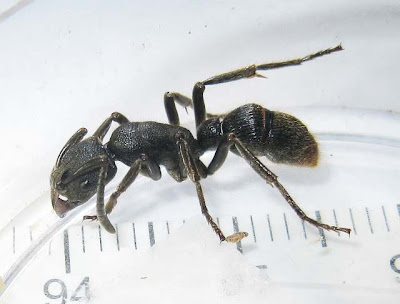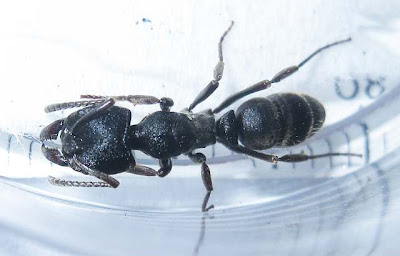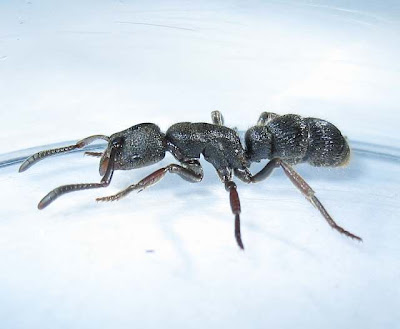This post previously listed as Pachycondyla is no longer (by the decree of the proclaimed and acclaimed Superlatives experts) of the genus Pachycondyla which has been since 2014 C.E. been redefined to be strictly just Neotropic ants that are to be found no where else except in the Neotropics (relating to or denoting a zoogeographical region comprising Central and South America, including the tropical southern part of Mexico and the Caribbean). Any species resembling by morphology or even genetics of this newly restrictedly redefined genus cannot be and must not be Pachycondyla.
So to obey this decree, all the species in this blog previously classified under Pachycondyla will be redefined as other genera as per this decree. This will be as and when I can find the spare time (redefining still on going).
This post consist of genera of Ponerinae and other subfamilies of ants (previously under the genus Pachycondyla) which have hunter queens. Maybe one day when I have tons of times to spare and nothing better to do, I may redo this post in entirely (instead of a just a cosmetic touch up).
Some of the species (of this location) of the ants in this post are specialist termites hunters. Specialist termite hunters (also includes other arthropods such as centipede) tackle termites differently from other ants that do not specialized on termites. When they encounter termites they kill as many as they can before starting to carry them back to their nest or eat them. They must have 'evolved' this technique to get a higher harvest rate. They also typically stuffed their mandibles with as many as they can carry and not carrying them back one at a time.
Most species are mostly subterranean (at least during the day) and tunneled through the forest soil hunting their preys.
Like Odontoponera, most species of Ponerinae (and also some other subfamily of similar morphology) similarly have 'slippery' feet and the gyne are semi-claustral and hunts for food during the development of her first brood of workers.
Some small species (of the sub tropical region) are currently listed as invasive species and are widely found in the U.S. and known locally as stinging needle ants.
Here then is the decree of the proclaimed and acclaimed Superlative experts on the genus Pachycondyla since redefined, an extract from the Zooxata: The tribal and generic classification of the diverse ant subfamily Ponerinae (Hymenoptera: Formicidae) is revised to reflect recent molecular phylogenetic information and a reappraisal of ponerine morphological diversity. The monogeneric tribe Thaumatomyrmecini (Thaumatomyrmex) is newly synonymized under Ponerini (syn. nov.), and the diverse genus Pachycondyla is fragmented into 19 genera, largely along the lines of its junior synonyms: Bothroponera, Brachyponera (gen. rev.), Ectomomyrmex (gen. rev.), Euponera (gen. rev.), Hagensia (gen. rev.), Megaponera (gen. rev.), Mesoponera (gen. rev.), Neoponera (gen. rev.), Ophthalmopone (gen. rev.), Pachycondyla, Paltothyreus (gen. rev.), Pseudoneoponera (gen. rev.), Pseudoponera (gen. rev.), and 6 new genera: Austroponera (gen. nov.), Buniapone (gen. nov.), Fisheropone (gen. nov.), Mayaponera (gen. nov.), Parvaponera (gen. nov.) and Rasopone (gen. nov.).
Most species are mostly subterranean (at least during the day) and tunneled through the forest soil hunting their preys.
Like Odontoponera, most species of Ponerinae (and also some other subfamily of similar morphology) similarly have 'slippery' feet and the gyne are semi-claustral and hunts for food during the development of her first brood of workers.
Some small species (of the sub tropical region) are currently listed as invasive species and are widely found in the U.S. and known locally as stinging needle ants.
Here then is the decree of the proclaimed and acclaimed Superlative experts on the genus Pachycondyla since redefined, an extract from the Zooxata: The tribal and generic classification of the diverse ant subfamily Ponerinae (Hymenoptera: Formicidae) is revised to reflect recent molecular phylogenetic information and a reappraisal of ponerine morphological diversity. The monogeneric tribe Thaumatomyrmecini (Thaumatomyrmex) is newly synonymized under Ponerini (syn. nov.), and the diverse genus Pachycondyla is fragmented into 19 genera, largely along the lines of its junior synonyms: Bothroponera, Brachyponera (gen. rev.), Ectomomyrmex (gen. rev.), Euponera (gen. rev.), Hagensia (gen. rev.), Megaponera (gen. rev.), Mesoponera (gen. rev.), Neoponera (gen. rev.), Ophthalmopone (gen. rev.), Pachycondyla, Paltothyreus (gen. rev.), Pseudoneoponera (gen. rev.), Pseudoponera (gen. rev.), and 6 new genera: Austroponera (gen. nov.), Buniapone (gen. nov.), Fisheropone (gen. nov.), Mayaponera (gen. nov.), Parvaponera (gen. nov.) and Rasopone (gen. nov.).
The 10 millimeters worker. Ectomomyrmex leeuwenhoeki has really tiny rudimentary eyes. There are several look alike species of around the same size (TL varying from 9 to 11 mm) that looks very similar.
A worker of Ectomomyrmex leeuwenhoeki .
Ectomomyrmex leeuwenhoeki workers with larvae. Ectomomyrmex leeuwenhoeki are among what I called the fat species.
Ectomomyrmex Sp02.
A worker of a small species. This is a much smaller species at 6 mm. It is around half the size of the species listed above.
Ectomomyrmex sp03.
Here is an even smaller species. An alate gyne (5mm) and worker (4.8mm). A drop of 1.2 mm in size may not seem much but in this case the 6 mm species is 25% larger than the 4.8mm species.
Similar to Odontomachus, Odontoponera and Diacamma, The male or drone of this genus looks like wasp. Their antennae are "without" the characteristic elbow.
Mesoponera sp4.
A sleek and polished species. This species of Mesoponera is at 9 mm total length
Brachyponera sp5.
This species resembles the previous species but is only a fraction of its size at slightly over 3 mm.
Workers of a polish and sleek looking species of Brachyponera.
Brachyponera sp6.
Another small Brachyponera species.
This species is unique in that the gaster color is different from the body main. It could be an anomaly, possibly infection.SP14
A large species with workers measuring over 17 millimeters. This species is almost identical to Pseudoneoponera tridentata except for a slight size different of around 2 millimeters. Also the petiole of Pseudoneoponera tridentata is more prominent both broader and higher and having three tiny spines.Another large species with workers measuring 14 millimeters. This species is a Ectomomyrmex astuta look alike but is significantly larger.
Pseudoneoponera sp(14)
This species resembles Pseudoneoponera tridentata but at around 12 millimeters is significantly smaller.
Worker of Pseudoneoponera tridentata
Buniapone amblyops, a species that look like a cross between ex Pachycondyla and Leptogenys. This species the workers only have rudimentary eyes. This mid size ant hunts both alone and in packs.
Measuring around 8 millimeters this monomorphic ant is as effective a solitary hunter as Diacamma and Odontoponera.
Ectomomyrmex astuta worker.
Ectomomyrmex astuta worker.
See also: (in the midst of being revised)
Ectomomyrmex sp(18)
Ectomomyrmex sp(03)
Mesoponera sp(02)
Taxonomy
No rank: cellular organisms 131567
Superkingdom (Domain): Eukaryota 2759
No rank: Opisthokonta 33154
Kingdom: Metazoa 33208
No rank: Eumetazoa 6072
No rank (Subkingdom): Bilateria 33213
No rank (Branch): Protostomia 33317
No rank (Infrakingdom): Ecdysozoa
No rank (Superphylum): Panarthropoda 88770
Phylum: Arthropoda 6656
No rank (Subphylum): Mandibulata 197563
No rank: Pancrustacea 197562
Subphylum (Epiclass): Hexapoda 6960
Class: Insecta 50557
No rank (Subclass): Dicondylia 85512
Subclass (Infraclass): Pterygota 7496
Infraclass: Neoptera 33340
Cohort: Holometabola
Order: Hymenoptera 7399
Suborder Apocrita 7400
Infraorder: Aculeata 7434
Superfamily: Formicoidea
Family: Formicidae 36668
Subfamily: Ponerinae 43085
Tribe: Ponerini 141711
Superkingdom (Domain): Eukaryota 2759
No rank: Opisthokonta 33154
Kingdom: Metazoa 33208
No rank: Eumetazoa 6072
No rank (Subkingdom): Bilateria 33213
No rank (Branch): Protostomia 33317
No rank (Infrakingdom): Ecdysozoa
No rank (Superphylum): Panarthropoda 88770
Phylum: Arthropoda 6656
No rank (Subphylum): Mandibulata 197563
No rank: Pancrustacea 197562
Subphylum (Epiclass): Hexapoda 6960
Class: Insecta 50557
No rank (Subclass): Dicondylia 85512
Subclass (Infraclass): Pterygota 7496
Infraclass: Neoptera 33340
Cohort: Holometabola
Order: Hymenoptera 7399
Suborder Apocrita 7400
Infraorder: Aculeata 7434
Superfamily: Formicoidea
Family: Formicidae 36668
Subfamily: Ponerinae 43085
Tribe: Ponerini 141711
Last Updated: 2021 07 21
First Posted: 2011 01 11
© 2011 – 2021 Quah. All rights reserved.
First Posted: 2011 01 11
© 2011 – 2021 Quah. All rights reserved.




























No comments:
Post a Comment
Sorry Guys, Google Chrome or Blogger bugs prevent me from replying to comments again. It keeps telling me to sign in (even though I am always sign in) but when I click to sign in, it tells me "Unable to sign in check Google profile'. So sorry I can't reply to your comments.
Alternatively you can sent me an email if you are in need of answers.
Note: Only a member of this blog may post a comment.